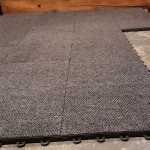How To Add Radiant Floor Heating
Radiant floor heating is a great way to add comfort and warmth to your home. It's also a very energy-efficient way to heat your home, as it uses less energy than traditional forced-air heating systems. If you're thinking about adding radiant floor heating to your home, here's what you need to know.
Types of Radiant Floor Heating Systems
There are two main types of radiant floor heating systems: hydronic and electric. Hydronic systems use hot water to heat the floor, while electric systems use electricity to heat the floor. Hydronic systems are more expensive to install than electric systems, but they are also more energy-efficient.
Installing Radiant Floor Heating
Installing radiant floor heating is a job that is best left to a professional. However, if you're handy and have some experience with home improvement projects, you may be able to install it yourself. Here are the steps involved in installing radiant floor heating:
- Prepare the subfloor. The subfloor must be level and smooth before the radiant floor heating can be installed. If the subfloor is not level, you will need to level it with a self-leveling compound.
- Install the insulation. Insulation is installed on top of the subfloor to help prevent heat loss. The type of insulation you use will depend on the type of radiant floor heating system you are installing.
- Install the radiant floor heating system. The radiant floor heating system is installed on top of the insulation. The type of radiant floor heating system you install will determine how it is installed.
- Install the flooring. The flooring is installed on top of the radiant floor heating system. The type of flooring you choose will depend on the type of radiant floor heating system you are installing.
Benefits of Radiant Floor Heating
Radiant floor heating offers a number of benefits over traditional forced-air heating systems. These benefits include:
- Radiant floor heating is more comfortable. Radiant floor heating radiates heat evenly throughout the room, so there are no cold spots. This makes it more comfortable to walk on and sit on than a cold floor.
- Radiant floor heating is more energy-efficient. Radiant floor heating uses less energy than traditional forced-air heating systems. This is because radiant floor heating does not have to heat the air in the room, it only needs to heat the floor.
- Radiant floor heating is healthier. Radiant floor heating does not circulate dust and allergens like forced-air heating systems do. This makes it a healthier option for people with allergies or asthma.
Conclusion
Radiant floor heating is a great way to add comfort and warmth to your home. It's also a very energy-efficient way to heat your home. If you're thinking about adding radiant floor heating to your home, be sure to talk to a professional to see if it's right for you.

How We Install Radiant In Floor Heat

Radiant Heating Department Of Energy

How To Install Under Floor Radiant Tubing With Aluminum Omega Heat Transfer Plates Between Joists

Radiant Floor Heating Install Ken Philp Climatecare

Janes Radiant Install Floor Heating Yourself

How To Install Hardwood Floors Over Radiant Heat American Information Center

How To Install Heated Floors For Tile

Radiant Heating Floor Leveling Heated Concrete Application

Radiant Floor Heating Systems Buyers Guide 2024 Warmup

How To Install Heated Floors The Home








